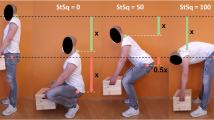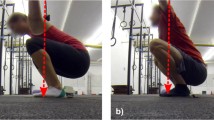Summary
There are actually no sufficient data for lifting technique assessment. A laboratory study was undertaken to determine the effect of 3 regular lifting techniques on erector muscle activation, cardiovascular strain and subjective response. Thirty student volunteers participated in the study, and were required to lift a weight with different techniques. Stoop-, squat-, semi-squat-lifting resulted in 3, 2 and 1 time of the highest percentage of the maximum voluntary electrical activation (MVE%) respectively. In the same order, the lowest median frequency (MF) existed 1, 1 and 2 times. Muscle fatigue was 4 times in squat, 36 in semi-squat and 43 in stoop lifting. Heart rate was the highest in squat and lowest in stoop respectively, with a middle level in semi-squat lifting. It may be recommended to adopt mainly the semi-squat technique for daily lifting works. For heavy lifting, it should use the squat technique. Stoop lifting may also be used alternatively but for light things.
Similar content being viewed by others
References
Schaffer H. Back injuries associated with lifting. Washington, DC: Bulletin of the US Bureau of Labor Statistics, 1982,2144
Putz-Anderson V, Bernard BP, Burt SE, et al. Musculoskeletal disorders and workplace factors: a critical review of epidemiologic evidence for work related musculoskeletal disorders of the neck, upper extremity, and low back. US Dept. of Health and Human Services, Public Health Service, Centers for Disease Control and Prevention, National Institute for Occupational Safety and Health, 1997
Straker L. Evidence to support using squat, semi-squat and stoop techniques to lift low-lying objects. Int J Ind Ergon, 2003,31(3):149–160
Luttmann A, Jager M, Laurig W. Electromyographical indication of muscular fatigue in occupational field studies. Int J Ind Ergon, 2000,25(6):645–660
Hägg GM, Luttmann A, Jäger M. Methodologies for evaluating electromyographic field data in ergonomics. J Electromyogr Kinesiol, 2000,10(5):301–312
Burgess-Limerick R. Squat, stoop, or something in between? Int J Ind Ergon, 2003,31(3):143–148
Hagen KB, Harms-Ringdahl K, Hallén J. Influence of lifting technique on perceptual and cardiovascular responses to submaximal repetitive lifting. Eur J Appl Physiol Occup Physiol, 1994,68(6):477–482
Larivière C, Arsenault AB, Gravel D, et al. Surface electromyography assessment of back muscle intrinsic properties. J Electromyogr Kinesiol, 2003,13(4):305–318
De Luca CJ. Use of the surface EMG signal for performance evaluation of back muscles. Muscle Nerve, 1993,16(2):210–216
Luttmann A, Sökeland J, Laurig W. Electromyographical study on surgeons in urology. I. Influence of the operating technique on muscular strain. Ergonomics, 1996,9(2): 285–297
Bonato P, Gagliati G., Knaflitz M, et al. Analysis of myoelectric signals recorded during dynamic contractions—a time-frequency approach to assessing muscle fatigue. IEEE Eng Med Biol, 1996,15(6):102–111
Beck TW, Housh TJ, Johnson GO, et al. Comparison of Fourier and wavelet transform procedures for examining the mechanomyographic and electromyographic frequency domain responses during fatiguing isokinetic muscle actions of the biceps brachii. J Electromyogr Kinesiol, 2005,15(2):190–199
Author information
Authors and Affiliations
Corresponding author
Additional information
This project was supported in part by a grant from the Chinese Ministry of Science and Technology (No. 2006BAI06B08).
Rights and permissions
About this article
Cite this article
Wang, Z., Wu, L., Sun, J. et al. Squat, stoop, or semi-squat: A comparative experiment on lifting technique. J. Huazhong Univ. Sci. Technol. [Med. Sci.] 32, 630–636 (2012). https://doi.org/10.1007/s11596-012-1009-3
Received:
Published:
Issue Date:
DOI: https://doi.org/10.1007/s11596-012-1009-3




